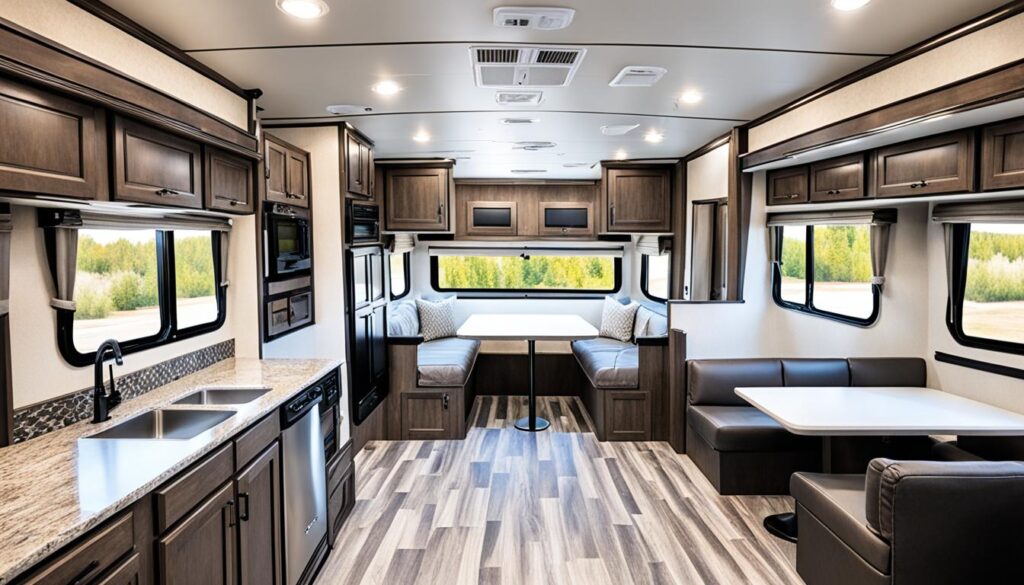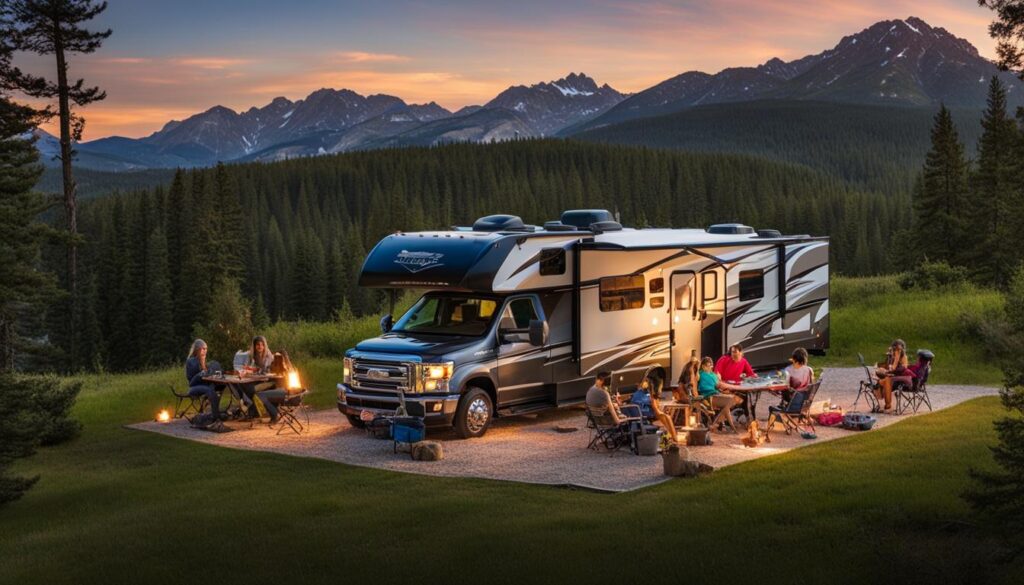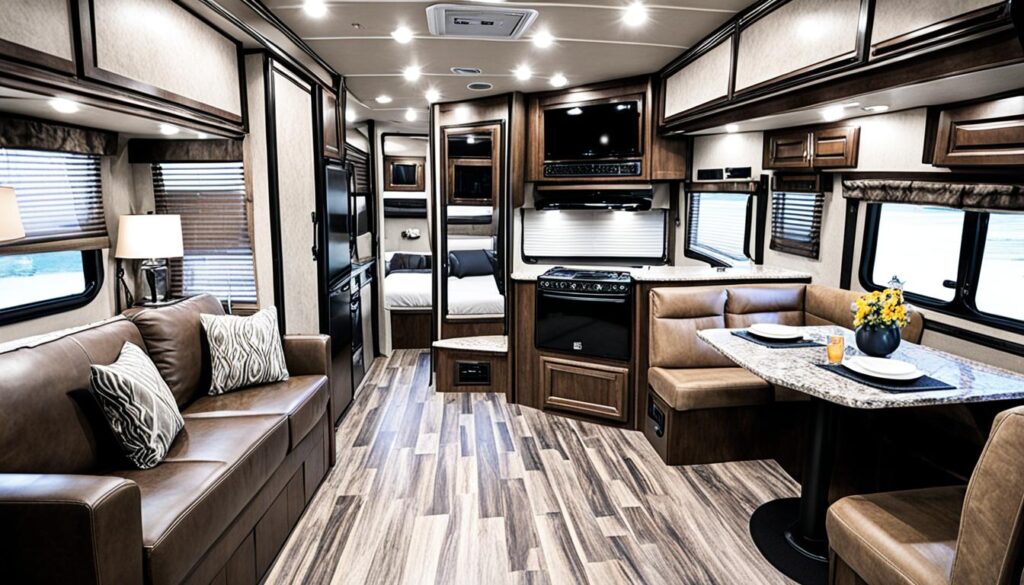Have you ever wondered how much living space is packed inside a 40-foot RV? The answer may not be as straightforward as you think. While the length of the RV is a crucial factor, determining the square footage requires considering other variables as well.
Calculating the square footage of a 40-foot RV involves multiplying the length by the width. However, keep in mind that the dimensions can vary depending on the make and model of the vehicle. Most RVs are approximately 8 feet wide, which means a 40-foot RV would have an estimated square footage of around 320 square feet.
But here’s the catch: this is just a rough estimation. The actual square footage can be influenced by factors such as the interior layout, the presence of slide-outs, and additional features. To obtain a more accurate measurement, it is best to refer to the manufacturer’s specifications or measure the interior space yourself.
Key Takeaways:
- The square footage of a 40-foot RV can vary based on the make, model, and interior features.
- To estimate the square footage, multiply the length of the RV by the width. However, this is just an approximation.
- Factors such as the interior layout, presence of slide-outs, and additional features can impact the actual square footage of the RV.
- Refer to the manufacturer’s specifications or measure the interior space yourself for a more accurate measurement.
- Consider the overall livability and functionality of an RV, rather than relying solely on square footage, when making a purchasing decision.
Contents
- 1 RVIA Guidelines: Maximum Sizes and Dimensions for RVs
- 2 Factors Affecting RV Square Footage: Slides, Layouts, and Features
- 3 How Does RV Model Number Correspond to Square Footage?
- 4 Comparing RVs to Determine Square Footage
- 5 Square Footage of Motorhomes vs. Campers
- 6 Pros and Cons of More Square Footage in an RV
- 7 Future Changes in RV Square Footage Restrictions
- 8 FAQ
- 9 Source Links
RVIA Guidelines: Maximum Sizes and Dimensions for RVs
The Recreational Vehicle Industry Association (RVIA) has established guidelines to regulate the maximum sizes and dimensions of RVs. These guidelines ensure safety, compliance with fire and motor vehicle standards, and consistency within the industry. Familiarizing yourself with these guidelines is essential when considering the purchase or customization of an RV.
Floor Space Restrictions
According to RVIA guidelines, there are specific floor space restrictions for different types of RVs. For travel trailers, the maximum allowed floor space is 400 square feet, providing ample room for living, cooking, sleeping, and other essential areas. On the other hand, fifth wheels have slightly more floor space restrictions, with a maximum allowance of 430 square feet. This extra space in fifth wheels allows for additional amenities and comforts.
“The floor space restrictions set by the RVIA ensure that RV manufacturers adhere to certain standards, guaranteeing a safe and comfortable experience for RV enthusiasts.”
It’s important to note that in April 2020, the RVIA made significant changes to the guidelines for fifth wheels. These changes eliminated the previous restrictions, allowing for longer and wider slides on fifth wheel RVs. The new guidelines provide more flexibility and creativity for manufacturers to design spacious and innovative fifth wheels, enhancing the overall RV experience.
Maximum Length and Width
In addition to floor space restrictions, the RVIA guidelines also specify the maximum length and width of RVs. For motorhomes, the maximum length allowed is 45 feet. This length provides enough space for comfortable living, including sleeping areas, a kitchen, a bathroom, and a seating/dining area. It is crucial to adhere to this length restriction to ensure easy maneuverability and compliance with road regulations.
For all types of RVs, including travel trailers, fifth wheels, and motorhomes, the maximum width allowed is 8.5 feet. This width restriction ensures that RVs can comfortably navigate roads and highways, reducing the risks associated with wider vehicles.
Image: RVIA Guidelines
By following these guidelines, RV manufacturers can create standardized and safe RVs that meet the needs and expectations of RV enthusiasts. It’s essential for RV owners and buyers to be aware of these guidelines to ensure compliance and make informed decisions when it comes to purchasing or modifying their RVs.
Factors Affecting RV Square Footage: Slides, Layouts, and Features
When it comes to the square footage of an RV, several factors come into play. One significant factor is the presence of slide-outs, which are sections of the RV that can extend outward to create additional living space. The number of slide-outs an RV has directly impacts its overall square footage when they are extended.
The layout of the interior is another crucial factor in determining the square footage of an RV. Different floor plan layouts can maximize space and provide more livable areas. Whether you prefer an open concept or separate living spaces, the floor plan plays a significant role in determining the overall square footage.
Additionally, various features within an RV can also affect its square footage. For instance, larger bathrooms, increased storage options, and unique design elements like vaulted ceilings or innovative storage solutions can impact the overall livable space. It’s essential to consider these features when selecting an RV that meets your specific space requirements.
In summary, the square footage of an RV is influenced by factors such as the presence of slide-outs, the layout of the interior, and the features incorporated into the design. By considering these factors, you can find an RV that provides the space and functionality you desire for your adventures on the road.

How Does RV Model Number Correspond to Square Footage?
RV model numbers can provide some insight into the length or square footage of the vehicle, although the correlation is not always consistent. In the past, certain model numbers did reflect the length or square footage of the RV. However, over time, these numbers have lost their specific meaning. Now, most model numbers stay under 40 to avoid being turned away from campgrounds due to perceived excessive length.
Instead of relying solely on the model number, it’s best to look at the floor plan and features of an RV to determine if it meets your space requirements. The floor plan and features will provide a much more accurate representation of the actual square footage of the RV.
Decoding RV model numbers can still provide some useful information about the make, model, and year of the RV. However, when it comes to determining the square footage, it is recommended to focus on the layout and features rather than relying solely on the model number.
Ultimately, the square footage of an RV is best determined by physically measuring the interior space or referring to the manufacturer’s specifications for accurate information.
Understanding RV Model Numbers
| Example | RV Model Number | RV Length | RV Square Footage |
|---|---|---|---|
| 1 | RV123 | 35 feet | 280 square feet |
| 2 | RV456 | 40 feet | 320 square feet |
| 3 | RV789 | 45 feet | 360 square feet |
Note: The table above is for illustrative purposes only and does not reflect actual RV model numbers or square footage.
Comparing RVs to Determine Square Footage
When comparing RVs to determine square footage, it’s crucial to evaluate the floor plans and consider the living space in each vehicle. RV floor plans can vary greatly among manufacturers, making it beneficial to visit RV trade shows or dealerships to walk through different rigs and observe the similarities and differences.
- Visualize yourself living in the space and imagine how the interior layout and features will meet your needs.
- Take note of the placement of furniture, ensuring it allows for comfortable movement and utilization of essential areas like the bedroom and bathroom.
- Consider how the interior looks with the slides pulled in, as this will affect the overall square footage and functionality of the RV.
By actively comparing the floor plans and visualizing the interior space, you can better gauge the actual living space in the RV and make an informed decision. Don’t rely solely on numbers or dimensions; instead, immerse yourself in the potential living experience of each RV you are considering.
As you explore different RVs, pay attention to details such as storage options, the layout of the kitchen and dining area, the size of the bathroom, and the availability of cozy sleeping quarters. These factors will greatly impact your comfort and satisfaction while on the road.
Remember, RV living is about more than just square footage. It’s about finding the right balance of livable space and features that fit your lifestyle and travel preferences.
Square Footage of Motorhomes vs. Campers
When comparing the square footage of motorhomes and campers, it’s important to consider the size and layout of these recreational vehicles. Both motorhomes and campers have varying square footage, which can impact their livability and comfort levels. To determine the square footage of an RV, you need to multiply its length by its width.
Motorhomes, particularly Class A RVs, tend to offer more square footage compared to campers. Class A motorhomes can range from 20 to 45 feet in length and provide ample space for families or larger groups, with some models even accommodating up to 10 people.
Campers, on the other hand, come in different sizes, ranging from 12 to 40 feet in length. Smaller campers are well-suited for solo travelers or couples, while larger campers are designed to accommodate families.
It’s important to note that the square footage of an RV is not solely determined by its length. The interior layout, presence of slide-outs, and additional features can also impact the overall livable space. A camper with a smart floor plan and well-utilized space can provide comparable square footage to a motorhome.
To provide a better understanding of the size differences between motorhomes and campers, here is a comparative table:
Square Footage Comparison: Motorhomes vs. Campers
| RV Type | Length Range | Maximum Square Footage |
|---|---|---|
| Class A Motorhomes | 20 – 45 feet | Varies, but typically larger |
| Campers | 12 – 40 feet | Varies, but typically smaller |
As shown in the table, Class A motorhomes generally offer more square footage compared to campers. However, it’s important to evaluate your specific needs and preferences when choosing between the two. Consider factors such as the number of occupants, desired amenities, and lifestyle requirements to determine which type of RV best suits your needs.
Pros and Cons of More Square Footage in an RV
When it comes to considering the square footage of an RV, there are several pros and cons to keep in mind. Larger RVs with more square footage offer numerous advantages, while compact RVs come with their own set of benefits.
Advantages of More Square Footage in RVs:
- Extended Dry Camping: Larger RVs provide more space for essential amenities, allowing you to dry camp for longer periods without the need for hookups.
- Overall Living Space: More square footage means a more spacious and comfortable living area, providing ample room for families or entertaining guests.
- Comfortable Accommodation: With increased square footage, larger RVs can comfortably accommodate larger families, ensuring everyone has their own space to relax and enjoy the trip.
Disadvantages of Larger RVs:
- Higher Energy Requirements: Larger RVs tend to consume more energy, which can result in higher fuel consumption and increased costs for heating, cooling, and other utilities.
- Parking and Maneuvering: Maneuvering larger RVs can be more challenging, especially in tight spaces or congested campgrounds, making it harder to find suitable parking spots.
- Restrictions in Certain Areas: Depending on the size and weight of a larger RV, certain campgrounds, national parks, or scenic routes may have restrictions or limitations, limiting your options for exploration.
- Increased Maintenance Costs: Bigger RVs often require more maintenance and upkeep, including regular servicing, repairs, and potential storage costs when not in use.
Benefits of Compact RVs:
- Driving and Parking Ease: Compact RVs are typically easier to drive and park, providing a more stress-free and maneuverable experience on the road.
- Lower Energy Requirements: Smaller RVs generally have lower energy consumption, resulting in reduced fuel costs and utility expenses.
- Potential Cost Savings: Compact RVs generally have lower maintenance costs, as they often require less upkeep and fewer repairs compared to their larger counterparts.
Considering the pros and cons of larger RVs with more square footage versus compact RVs is essential when determining which option best suits your needs. It’s important to evaluate your specific requirements, lifestyle preferences, and travel goals before making a decision.

Quote:
“Finding the right balance between living space and maneuverability is crucial when choosing an RV. Evaluate your needs, assess the advantages and disadvantages, and select the RV that aligns with your priorities.”
Future Changes in RV Square Footage Restrictions
The future of RV square footage restrictions is currently being debated and discussed by the Recreational Vehicle Industry Association (RVIA) and the federal government. The RVIA is actively lobbying for changes to the current restrictions, especially for fifth wheels and travel trailers. The existing restrictions, which limit the floor space of fifth wheels to 430 square feet and travel trailers to 400 square feet, are considered outdated and not aligned with the demands of the modern RV market.
The RVIA argues that with the increasing popularity of larger Class A motorhomes and the need to accommodate larger families and retirees, it’s crucial to modify the current square footage limits. They believe that these restrictions should be relaxed to allow for more flexibility in RV size and square footage options. By doing so, RV enthusiasts would have a wider range of choices to meet their individual preferences and needs.
While the future changes in RV square footage restrictions are yet to be determined, there is a growing anticipation that these limitations may be lifted in the coming years. This potential relaxation would provide greater freedom for RV manufacturers to design and build vehicles with increased square footage, offering more spacious and comfortable living areas for RV enthusiasts.
FAQ
How do I calculate the square footage of a 40-foot RV?
To calculate the square footage of a 40-foot RV, you need to multiply the length of the RV by the width. Most RVs are around 8 feet wide, so a 40-foot RV would have an estimated square footage of around 320 square feet. However, it’s important to note that this is just an estimate and the actual square footage can vary based on factors such as the interior layout and the presence of slide-outs.
What are the guidelines for the maximum sizes and dimensions of RVs?
The Recreational Vehicle Industry Association (RVIA) has established guidelines for the maximum sizes of RVs. According to these guidelines, travel trailers can have a maximum floor space of 400 square feet, while 5th wheels can have up to 430 square feet of floor space. Motorhomes have a maximum length of 45 feet, and the maximum width for all RVs is 8.5 feet. These guidelines ensure compliance with fire and motor vehicle standards.
What factors can affect the square footage of an RV?
Several factors can impact the square footage of an RV. The presence of slide-outs, which create additional living space when extended, can increase the overall square footage. The interior layout of the RV, including the placement of furniture and essential areas like the bedroom and bathroom, can also affect the livable space. Additionally, features such as larger bathrooms, increased storage, and unique design elements can impact the overall square footage of the RV.
Do RV model numbers correspond to square footage?
While RV model numbers can sometimes provide insight into the length or square footage of the vehicle, the correlation is not always consistent. In the past, some model numbers did reflect length or square footage, but over time, the numbers lost their meaning. It’s best to look at the floor plan and features of an RV to determine if it meets your space requirements, rather than relying solely on the model number.
How can I compare RVs to determine square footage?
When comparing RVs for square footage, it’s important to evaluate the floor plans and consider the livable space in each vehicle. Visit RV trade shows or dealerships to walk through different rigs and see the similarities and differences. Visualize yourself living in the space and consider how the interior layout and features will meet your needs. Take note of the placement of furniture, access to essential areas, and how the interior looks with the slides pulled in. This will help gauge the actual living space in the RV and make an informed decision.
What is the square footage difference between motorhomes and campers?
The square footage of motorhomes and campers can vary based on their size. Class A motorhomes, which are the largest class, tend to be larger than most campers and offer more square footage. Class A motorhomes can range from 20 to 45 feet in length, with some models having the ability to sleep up to 10 people. Campers, on the other hand, can vary in size from 12 to 40 feet in length, with smaller campers best suited for 1 to 2 people and larger campers accommodating families.
What are the pros and cons of more square footage in an RV?
Larger RVs with more square footage offer advantages such as more overall living space, the ability to dry camp for longer without hookups, and comfortable accommodation for larger families. However, larger RVs also require more energy to run, can be harder to park and maneuver, may have restrictions in certain campgrounds or on certain roads, and can be more expensive to maintain. Compact RVs, on the other hand, are easier to drive and park, have lower energy requirements, and may have lower maintenance costs. It’s important to weigh the pros and cons and consider your specific needs before deciding on the square footage of an RV.
Will there be changes in RV square footage restrictions in the future?
The RVIA has been lobbying the federal government to change the current square footage restrictions for RVs, particularly for fifth wheels and travel trailers. These restrictions, which limit the floor space for fifth wheels to 430 square feet and travel trailers to 400 square feet, are seen as outdated by the RVIA. The RVIA argues that these restrictions should be modified to accommodate the growing trend of larger Class A motorhomes and provide more options for families and retirees. It is anticipated that these restrictions may be lifted in the future, allowing for more flexibility in RV size and square footage options.






